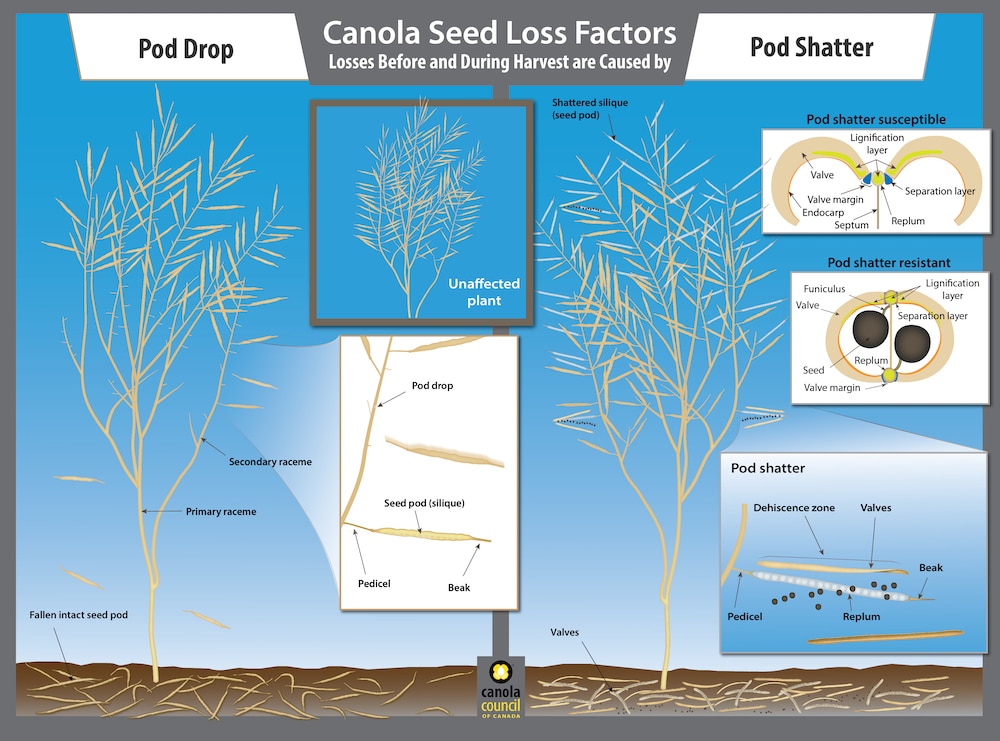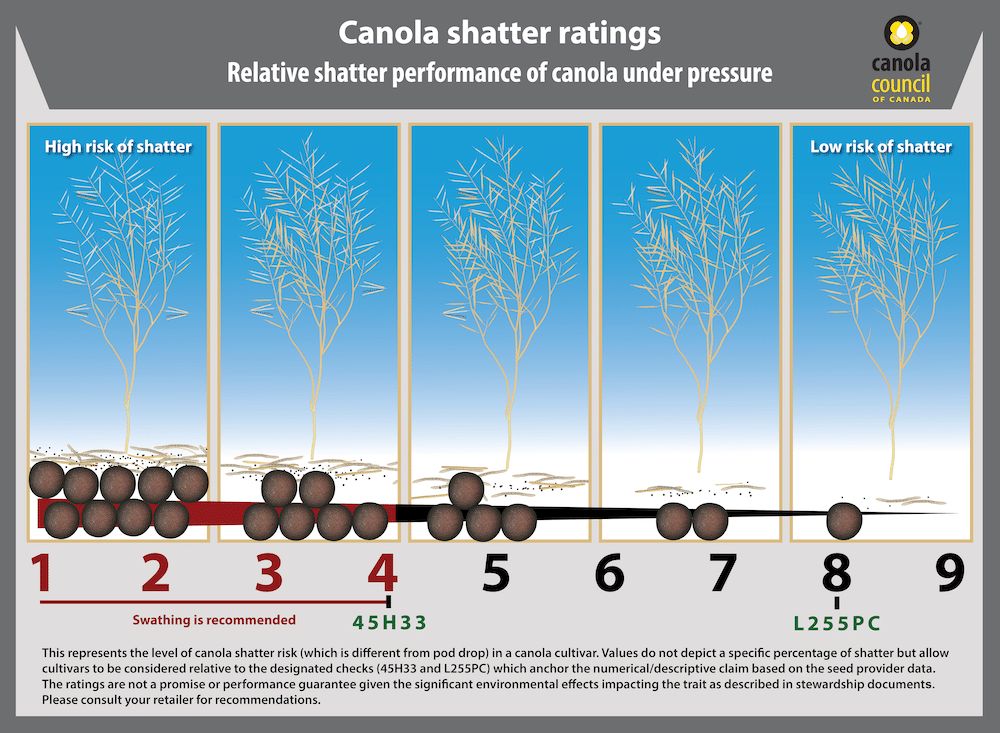A thin, drought-stressed canola crop – where plants are shorter, canopy is open and yield potential is low – will require some extra considerations at harvest to preserve yield and limit any extra costs. Here are some common questions and answers to help with harvest decisions.
The common recommendation is to swath canola when the main stem has 60 per cent seed colour change. Does this target change in a thin, low-yielding crop?
During the drought stress of 2021, one Canola Council of Canada agronomy specialist observed in early August that seed colour change (SCC) seemed to be happening very slowly. Even so, all seeds on the short low-yielding plants were firm, not squishy. The agronomy question is whether to go ahead and cut that crop or keep waiting for some signs of colour change?
The specialists consulted for this article made the following recommendations:
- I would prefer to see some colour change. Maybe wait just a few extra days. There is always that trade off with shattering losses if you leave it too long.
- Do plants have side branches that need time to mature? If yes, wait for all seeds to get firm.
- Does the field have second-growth plants that emerged later that first ones? In that situation, judge how much yield is represented by those later plants and whether they’re close to maturity. If they’re starting to get meat in seeds, they might be worth saving – so cut later. However, it their seeds are all water, they will take minimum of two or three weeks to firm up, so you might not want to wait if it means risking earlier ones. However, if these later plants account for more yield potential, you may want to wait. More on harvesting uneven crops.
- We experienced slow colour change with the smoke in Alberta in 2018. With 2021 being another smoky year, perhaps that is why seeds are firming up but not changing colour. As long as seeds are firm, they will cure properly in the swath. The difference between 2018 and 2021 is that the smoke came later in 2018. In 2021, we’re having this discussion in early August. Farmers do not need to be in a big rush to swath those crops yet.
- Consider the forecast. Hot weather is not a good time to swath canola. It could lock in green.
- Waiting can increase yield and oil content. The green pods of canola contribute up to 35 per cent of the photosynthates needed by developing embryos. Seeds that are green and firm perform photosynthesis once they have reached their maximum size. This contributes to oil biosynthesis, but I am not sure about the yield contribution. It might be about five per cent.
- Maybe don’t swath at all. In severe drought conditions, there may not be enough straw to make a swath. If the swath falls through the stubble, then it can be very difficult to pick it up. In these situations, it’s better to straight cut and possibly include pre-harvest weed control. (See the next questions for more on swath versus straight cut.)
Do you recommend swathing or straight combining a thin stand?
Swathing: This prevents the loose, poorly knit crop from whipping in the wind and shattering, but without a lot of stubble, these thin stands are more likely to roll in the wind. However, without shatter tolerance, you’re still better to swath. Leave stubble as high as possible. Use the widest swather you can find to make sure swaths are larger. Roll swaths to keep them as tight as possible. Cut in direction of prevailing winds.
Straight combining: Standing canola doesn’t roll in the wind, and canola with shatter tolerance will be lower risk.
The specialists made the following recommendations:
- It is really a toss up.
- Whether swathing or straight combining, this canola will be at great risk from weather-related losses, so harvest as soon as possible.
- In severe drought conditions, there may not be enough straw to make a swath. If the swath falls through the stubble, then it can be very difficult to pick it up. In these situations, it’s better to straight cut and possibly include pre-harvest weed control. (Repeated from question one.)
- You want to leave as much stubble as possible to hold the swaths, but you also want enough crop material to make a swath. To keep the swath as tight as possible, adjust swather canvasses to bring them closer together to make a tighter swath. If this isn’t an option, speed up canvas so it throws material more. And use a roller to tighten the windrow and push it down.
- If straight cutting, consider pre-harvest weed control to remove any green weeds that may be growing in the thin canopy. More on pre-harvest products.


How do you adjust the combine to limit losses when stand is thin and keeping the combine full for grain on grain threshing is a challenge?
One way to limit seed loss out the back of the combine is to run the combine full for maximum grain-on-grain threshing. This can be a challenge for thin crop. This came up a few times in a Canola Watch podcast.
The specialists made the following recommendations:
On combine ground speed:
- In this situation, increased speed can help.
- However, header performance will likely limit how fast you can go. To maximize header performance, make sure cutting parts are in good shape and make sure reel speed is matched well with ground speed to limit threshing by the reel.
On concave spacing:
- Set it tighter than you normally would for canola. Adjust incrementally and check for losses.
- With a thin amount of material coming in, you can’t count on much grain on grain threshing. You will have to rely on the bars for that, so tighten the concave somewhat.
- Watch for cracking in the sample. Being overly aggressive with a tight concave can also damage canola. It’s a fine line.
On cylinder/rotor RPMs:
- Keep the same as you normally would for canola, at least to start.
- If pods not getting threshed, may have to speed up the rotor/cylinder somewhat.
On fan speed:
- Use a slightly lower fan speed because there isn’t as much material. Accept a somewhat dirtier sample.
- With not as much material going through the combine, you could blow seeds out the back with normal fan speed. This is like when you see losses go way up on combine monitor when material gets thin.
- A set of cleaning screens can be useful to check on the quality of seeds coming out the back of the combine. Some of the losses may be shivelled seeds that are dockage and won’t contribute to yield.
On sieves:
- Keep the same as you normally would for canola, at least to start.
The Canola Calculator has two tools that will help you work through the proper settings for a thin crop. These are the Combine Optimization Tool to set the combine and the Harvest Loss Calculator, which calculates loss based on drop pan measurements. The Canola Encyclopedia explains how to minimize loss and measure loss, including drop pan options. Results from the PAMI harvest loss survey.
In a drought situation, do you try to keep as much standing stubble as possible for water trapping and erosion control?
Tall stubble is about planning for next year. Stubble is important for erosion control and snow trap, but the first priority is to capture as much yield as possible from this year’s crop. Another consideration is harvestability. Swathing requires a balanced decision between stubble height at windrow size (bigger windrows are better for feeding the combine and grain-on-grain threshing), but you want enough stubble standing to keep those windrows in place. With straight cutting, you want to put enough material through the combine to improve threshing performance.
The specialists made the following recommendations:
- Anchored stubble is the key for erosion control. For this purpose, height doesn’t matter as much.
- Taller stubble will trap more snow. Tall stubble also means less residue going through the combine and ending up on the soil surface, but this second factor isn’t the issue in a thin crop when you need that material going into the combine.
- Protecting yield would outweigh the additional snow trap.
- If straight cutting and canola is hard to feed into the header, Duck Foot modifications for the reel tines can help.
Do you need a pre-harvest product for a thin, drought-stressed crop?
This article was prepared in mid August of 2021. With time to let the thin crop dry down, a pre-harvest product may not be necessary – especially if the crop is relatively even and with minimal weed growth.
The specialists made the following recommendations:
- Low rain often means low weed growth. In fields I’ve checked, weeds growth is fairly low.
- You may not need to spray the whole field. Maybe just low areas that are still green or weedy.
- Pre-harvest spray shouldn’t be needed unless in situations with kochia (or other weeds) that require desiccation.
- If you’re investing in next year I’d go with glyphosate to help with weeds. If it’s early, maybe wait for some rain and do a post harvest instead.
Any other harvest tips you have for thin, drought-stressed canola?
- Harvesting thin crops in August could increase storage risk. With uneven fields, you are more likely to have seed at varying moisture. Storage could be an issue. Especially if going into the bin hot, even if at eight or nine per cent average moisture.
- With hot grain, turn on aeration fans to cool it down and remove sweated moisture. Conditioning tips.
Thank you to our specialists who helped with this article:
Shawn Senko, CCC agronomy specialist
John Mayko, Alberta farmer and director at Alberta Canola. Former CCC agronomy specialist.
Rob Dunn, cropping system specialist with FarmWise. Based in Lethbridge, Alberta
Ken Coles, executive director at Farming Smarter, Lethbridge, Alberta
Raju Soolanayakanahally, research scientist with Agriculture and Agri-Food Canada
